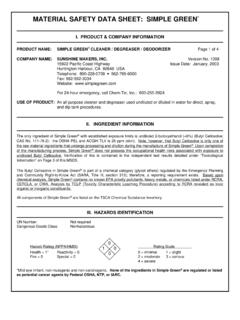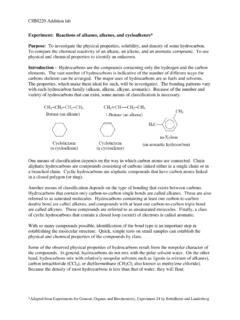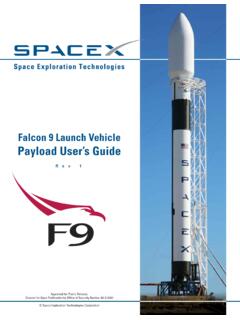Transcription of MATERIAL SAFETY DATA SHEET Gasoline, All Grades MSDS …
1 MATERIAL SAFETY DATA SHEET Gasoline, All Grades MSDS No. 9950 Revision Date: 09/25/2007 Page 1 of 9 NFPA 704 (Section 16) EMERGENCY OVERVIEW DANGER! EXTREMELY FLAMMABLE - EYE AND MUCOUS MEMBRANE IRRITANT - EFFECTS CENTRAL NERVOUS SYSTEM - HARMFUL OR FATAL IF SWALLOWED - ASPIRATION HAZARD High fire hazard. Keep away from heat, spark, open flame, and other ignition sources. If ingested, do NOT induce vomiting, as this may cause chemical pneumonia (fluid in the lungs). Contact may cause eye, skin and mucous membrane irritation. Harmful if absorbed through the skin. Avoid prolonged breathing of vapors or mists. Inhalation may cause irritation, anesthetic effects (dizziness, nausea, headache, intoxication), and respiratory system effects.
2 Long-term exposure may cause effects to specific organs, such as to the liver, kidneys, blood, nervous system, and skin. Contains benzene, which can cause blood disease, including anemia and leukemia. 1. CHEMICAL PRODUCT and COMPANY INFORMATION Hess Corporation 1 Hess Plaza Woodbridge, NJ 07095-0961 EMERGENCY TELEPHONE NUMBER (24 hrs): CHEMTREC (800)424-9300 COMPANY CONTACT (business hours): Corporate SAFETY (732)750-6000 MSDS (Environment, Health, SAFETY ) Internet Website SYNONYMS: Hess Conventional (Oxygenated and Non-oxygenated) Gasoline; Reformulated Gasoline (RFG); Reformulated Gasoline Blendstock for Oxygenate Blending (RBOB); Unleaded Motor or Automotive Gasoline See Section 16 for abbreviations and acronyms.
3 2. COMPOSITION and INFORMATION ON INGREDIENTS * INGREDIENT NAME (CAS No.) CONCENTRATION PERCENT BY WEIGHT Gasoline (86290-81-5) 100 Benzene (71-43-2) - ( - reformulated gasoline) n-Butane (106-97-8) < 10 Ethyl Alcohol (Ethanol) (64-17-5) 0 - 10 Ethyl benzene (100-41-4) < 3 n-Hexane (110-54-3) to 4 Methyl-tertiary butyl ether (MTBE) (1634-04-4) 0 to Tertiary-amyl methyl ether (TAME) (994-05-8) 0 to Toluene (108-88-3) 1 - 25 1,2,4- Trimethylbenzene (95-63-6) < 6 Xylene, mixed isomers (1330-20-7) 1 - 15 A complex blend of petroleum-derived normal and branched-chain alkane, cycloalkane, alkene, and aromatic hydrocarbons.
4 May contain antioxidant and multifunctional additives. Non-oxygenated Conventional Gasoline and RBOB do not have oxygenates (Ethanol or MTBE and/or TAME). MATERIAL SAFETY DATA SHEET Gasoline, All Grades MSDS No. 9950 Revision Date: 09/25/2007 Page 2 of 9 Oxygenated Conventional and Reformulated Gasoline will have oxygenates for octane enhancement or as legally required. 3. HAZARDS IDENTIFICATION EYES Moderate irritant. Contact with liquid or vapor may cause irritation. SKIN Practically non-toxic if absorbed following acute (single) exposure. May cause skin irritation with prolonged or repeated contact.
5 Liquid may be absorbed through the skin in toxic amounts if large areas of skin are exposed repeatedly. INGESTION The major health threat of ingestion occurs from the danger of aspiration (breathing) of liquid drops into the lungs, particularly from vomiting. Aspiration may result in chemical pneumonia (fluid in the lungs), severe lung damage, respiratory failure and even death. Ingestion may cause gastrointestinal disturbances, including irritation, nausea, vomiting and diarrhea, and central nervous system (brain) effects similar to alcohol intoxication. In severe cases, tremors, convulsions, loss of consciousness, coma, respiratory arrest, and death may occur.
6 INHALATION Excessive exposure may cause irritations to the nose, throat, lungs and respiratory tract. Central nervous system (brain) effects may include headache, dizziness, loss of balance and coordination, unconsciousness, coma, respiratory failure, and death. WARNING: the burning of any hydrocarbon as a fuel in an area without adequate ventilation may result in hazardous levels of combustion products, including carbon monoxide, and inadequate oxygen levels, which may cause unconsciousness, suffocation, and death. CHRONIC EFFECTS and CARCINOGENICITY Contains benzene, a regulated human carcinogen. Benzene has the potential to cause anemia and other blood diseases, including leukemia, after repeated and prolonged exposure.
7 Exposure to light hydrocarbons in the same boiling range as this product has been associated in animal studies with systemic toxicity. See also Section 11 - Toxicological Information. MEDICAL CONDITIONS AGGRAVATED BY EXPOSURE Irritation from skin exposure may aggravate existing open wounds, skin disorders, and dermatitis (rash). Chronic respiratory disease, liver or kidney dysfunction, or pre-existing central nervous system disorders may be aggravated by exposure. 4. FIRST AID MEASURES EYES In case of contact with eyes, immediately flush with clean, low-pressure water for at least 15 min. Hold eyelids open to ensure adequate flushing.
8 Seek medical attention. SKIN Remove contaminated clothing. Wash contaminated areas thoroughly with soap and water or waterless hand cleanser. Obtain medical attention if irritation or redness develops. INGESTION MATERIAL SAFETY DATA SHEET Gasoline, All Grades MSDS No. 9950 Revision Date: 09/25/2007 Page 3 of 9 DO NOT INDUCE VOMITING. Do not give liquids. Obtain immediate medical attention. If spontaneous vomiting occurs, lean victim forward to reduce the risk of aspiration. Small amounts of MATERIAL which enter the mouth should be rinsed out until the taste is dissipated. INHALATION Remove person to fresh air. If person is not breathing, ensure an open airway and provide artificial respiration.
9 If necessary, provide additional oxygen once breathing is restored if trained to do so. Seek medical attention immediately. 5. FIRE FIGHTING MEASURES FLAMMABLE PROPERTIES: FLASH POINT: -45 oF (-43oC) AUTOIGNITION TEMPERATURE: highly variable; > 530 oF (>280 oC) OSHA/NFPA FLAMMABILITY CLASS: 1A (flammable liquid) LOWER EXPLOSIVE LIMIT (%): UPPER EXPLOSIVE LIMIT (%): FIRE AND EXPLOSION HAZARDS Vapors may be ignited rapidly when exposed to heat, spark, open flame or other source of ignition. Flowing product may be ignited by self-generated static electricity. When mixed with air and exposed to an ignition source, flammable vapors can burn in the open or explode in confined spaces.
10 Being heavier than air, vapors may travel long distances to an ignition source and flash back. Runoff to sewer may cause fire or explosion hazard. EXTINGUISHING MEDIA SMALL FIRES: Any extinguisher suitable for Class B fires, dry chemical, CO2, water spray, fire fighting foam, or Halon. LARGE FIRES: Water spray, fog or fire fighting foam. Water may be ineffective for fighting the fire, but may be used to cool fire-exposed containers. During certain times of the year and/or in certain geographical locations, gasoline may contain MTBE and/or TAME. Firefighting foam suitable for polar solvents is recommended for fuel with greater than 10% oxygenate concentration - refer to NFPA 11 Low Expansion Foam - 1994 Edition.








